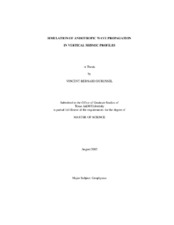| dc.contributor.advisor | Gibson, Richard L. | |
| dc.creator | Durussel, Vincent Bernard | |
| dc.date.accessioned | 2004-09-30T02:08:59Z | |
| dc.date.available | 2004-09-30T02:08:59Z | |
| dc.date.created | 2002-08 | |
| dc.date.issued | 2004-09-30 | |
| dc.identifier.uri | https://hdl.handle.net/1969.1/535 | |
| dc.description.abstract | The influence of elastic anisotropy on seismic wave propagation is often neglected for the sake of simplicity. However, ignoring anisotropy may lead to significant errors in the processing of seismic data and ultimately in a poor image of the subsurface. This is especially true in wide-aperture Vertical Seismic Profiles where waves travel both vertically and horizontally. Anisotropy has been neglected in wavefront construction methods of seismic ray-tracing until Gibson (2000), who showed they are powerful tools to simulate seismic wave propagation in three-dimensional anisotropic subsurface models. The code is currently under development using a C++ object oriented programming approach because it provides high flexibility in the design of new components and facilitates debugging and maintenance of a complex algorithm. So far, the code was used to simulate propagation in homogeneous or simple heterogeneous anisotropic velocity models mainly designed for testing purposes. In particular, it has never been applied to simulate a field dataset. We propose here an analytical method involving little algebra and that allows the design of realistic heterogeneous anisotropic models using the C++ object oriented programming approach. The new model class can model smooth multi-layered subsurface with gradients or models with many dip variations. It has been used to model first arrival times of a wide-aperture VSP dataset from the Gulf of Mexico to estimate the amount of anisotropy. The proposed velocity model is transversely isotropic. The anisotropy is constant throughout the model and is defined via Thomsen's parameters. Values in the final model are epsilon = 0.055 and delta = -0.115. The model is compatible with the a priori knowledge of the local geology and reduces the RMS average time difference between measured and computed travel times by 51% in comparison to the initial isotropic model. These values are realistic and are similar to other measurements of anisotropy in the Gulf of Mexico. | en |
| dc.format.extent | 1878447 bytes | en |
| dc.format.extent | 150893 bytes | en |
| dc.format.medium | electronic | en |
| dc.format.mimetype | application/pdf | |
| dc.format.mimetype | text/plain | |
| dc.language.iso | en_US | |
| dc.publisher | Texas A&M University | |
| dc.subject | seismic anisotropy | en |
| dc.subject | ray tracing | en |
| dc.subject | wavefront construction | en |
| dc.subject | object oriented programming | en |
| dc.title | Simulation of anisotropic wave propagation in Vertical Seismic Profiles | en |
| dc.type | Book | en |
| dc.type | Thesis | en |
| thesis.degree.department | Geology and Geophysics | en |
| thesis.degree.discipline | Geophysics | en |
| thesis.degree.grantor | Texas
A&M University | en |
| thesis.degree.name | Master of Science | en |
| thesis.degree.level | Masters | en |
| dc.contributor.committeeMember | Everett, Mark | |
| dc.contributor.committeeMember | Blasingame, Thomas | |
| dc.type.genre | Electronic Thesis | en |
| dc.type.material | text | en |
| dc.format.digitalOrigin | born digital | en |


